
Indiana
ITEP’s Neva Butkus Discusses Property Taxes in Indiana
October 3, 2024
On September 30, Policy Analyst Neva Butkus discussed Indiana property taxes and how Hoosiers could benefit from a circuit breaker policy at an event hosted by the Indiana Fiscal Policy Institute and Prosperity Indiana. Check out her slides here, and an article on the panel here.
Testimony of Prosperity Indiana’s Andrew Bradley Before the Indiana State and Local Tax Review Task Force
January 16, 2024
On January 10, Andrew Bradley, Policy Director at Prosperity Indiana, testified before the State and Local Tax Review Task Force of the Indiana General Assembly. During his presentation, Bradley highlighted Prosperity Indiana’s tax policy priorities and ITEP’s Who Pays? findings. To watch the video, click here (Bradley’s testimony begins at 1:55:40) To read written testimony […]
Indiana: Who Pays? 7th Edition
January 9, 2024 • By ITEP Staff
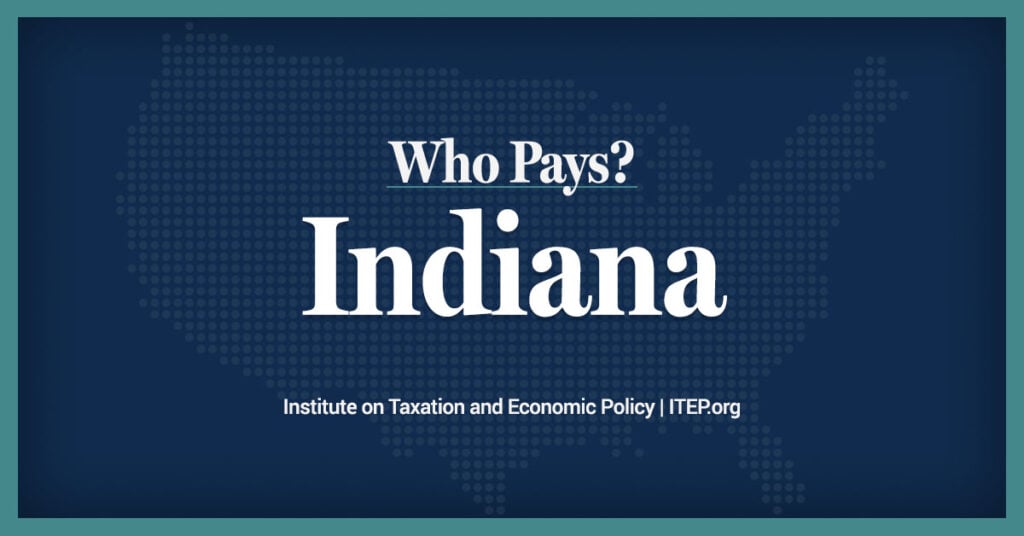
Indiana Download PDF All figures and charts show 2024 tax law in Indiana, presented at 2023 income levels. Senior taxpayers are excluded for reasons detailed in the methodology. Our analysis includes nearly all (99.8 percent) state and local tax revenue collected in Indiana. These figures depict Indiana’s flat personal income tax rate at 3.05 percent. […]
News and Tribune (Indiana): Editorial: Raising Sales Tax Would Hurt Poor Hoosiers
November 1, 2023
With statewide elections on the doorstep, some 2024 candidates are playing on a familiar ploy in calling for a reduction or an end to Indiana’s income tax. The most popular idea floated by those who are campaigning on the proposal, including current lieutenant governor and gubernatorial hopeful Suzanne Crouch, is to replace a sizable portion […]
Testimony of Neva Butkus Before the Indiana State and Local Tax Review Task Force
October 20, 2023
Today ITEP State Policy Analyst Neva Butkus presented to the Indiana State and Local Tax Review Task Force. For a related blog from Neva, click here. For her slide deck, click here. Good morning members of the State and Local Tax Review Task Force, Thank you for providing me the opportunity to share ITEP’s findings […]
Eliminating Indiana’s Income Tax Would Jeopardize Public Services & Create a Windfall for the Well-Off
October 19, 2023 • By Neva Butkus
Meaningful investments in Indiana’s future require a smart, and fair, tax code that recognizes current economic realities and can raise a sustainable stream of funding from those most able to pay.
News and Tribune: In Indiana and Illinois, Taxes Hit Low-earners Hard
October 25, 2018
TERRE HAUTE -- Low-earning residents of Indiana and Illinois pay a greater share of state and local taxes than those in all other Midwestern states, and those in most states nationally, according to a new study by a non-partisan think tank.
Indiana Institute for Working Families: New Analysis: Indiana’s Tax System is Among the Dozen Most Regressive in the Country
October 17, 2018
The new ‘Who Pays?’ analysis follows the Institute’s August report ‘The Status of Working Families in Indiana, 2018’ which found the wealthiest Indiana earners have received an extra $2,446 from combined state income, corporate, and fuel tax changes since 2012, while taxes for the bottom 60% of middle class and working families have increased by an average $36.
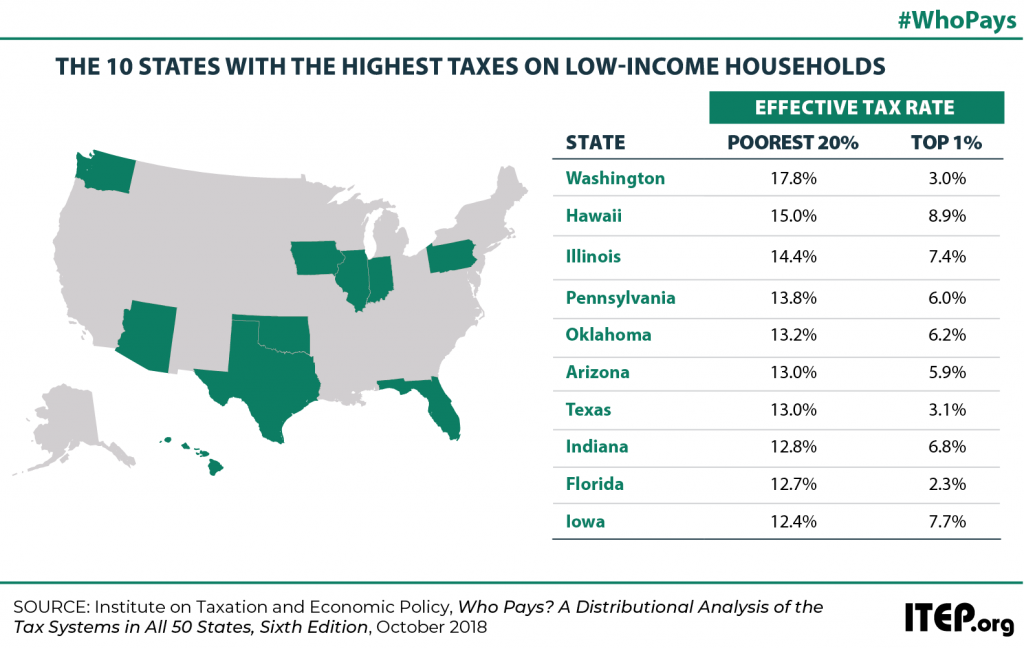
ITEP analysis reveals that many states traditionally considered to be “low-tax states” are actually high-tax for their poorest residents. The “low tax” label is typically assigned to states that either lack a personal income tax or that collect a comparatively low amount of tax revenue overall. But a focus on these measures can cause lawmakers to overlook the fact that state tax systems impact different taxpayers in very different ways, and that low-income taxpayers often do not experience these states as being even remotely “low tax.”
Low Tax for Whom? Indiana is a “Low Tax State” Overall, But Not for Families Living in Poverty
October 17, 2018 • By ITEP Staff
Indiana’s tax system has vastly different impacts on taxpayers at different income levels. For instance, the lowest-income 20 percent of Hoosiers contribute 12.8 percent of their income in state and local taxes — considerably more than any other income group in the state. For low-income families, Indiana is far from being a low tax state; in fact, it is the eighth highest-tax state in the country for low-income families.
Indiana: Who Pays? 6th Edition
October 17, 2018 • By ITEP Staff

INDIANA Read as PDF INDIANA STATE AND LOCAL TAXES Taxes as Share of Family Income Top 20% Income Group Lowest 20% Second 20% Middle 20% Fourth 20% Next 15% Next 4% Top 1% Income Range Less than $18,800 $18,800 to $36,100 $36,100 to $58,000 $58,000 to $92,300 $92,300 to $183,500 $183,500 to $436,100 over $436,100 […]
Tax Cuts 2.0 – Indiana
September 26, 2018 • By ITEP Staff
The $2 trillion 2017 Tax Cuts and Jobs Act (TCJA) includes several provisions set to expire at the end of 2025. Now, GOP leaders have introduced a bill informally called “Tax Cuts 2.0” or “Tax Reform 2.0,” which would make the temporary provisions permanent. And they falsely claim that making these provisions permanent will benefit […]
Indiana Institute for Working Families: The Status of Working Families in Indiana: 2018 Report
August 1, 2018
Indiana faces a choice of whether to continue down a southward-leading path of low-road policies, or to rebuild its economy for Hoosier families. By adopting a policy agenda for working families that improves Indiana’s jobs with higher wage and labor standards; strengthens protections for Hoosier families including repairing the safety net and crafting consumer and job safeguards; and increases economic mobility through improved access to education, rebalancing the state’s regressive tax and budget structure, and focusing economic development on strengthening Hoosier families and communities, Indiana can reclaim its place as a leader in the Midwest and in the nation.
Gas Taxes Rise in Seven States, Including an Historic Increase in Oklahoma
June 26, 2018 • By Carl Davis
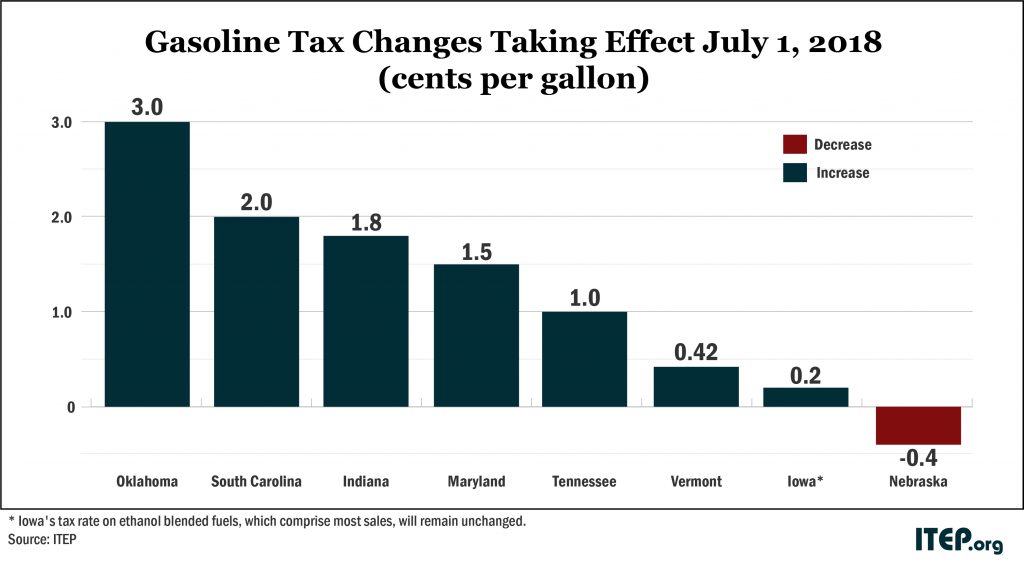
A rare sight is coming to Oklahoma. The last time the Sooner State raised its gas tax rate, the Berlin Wall was still standing, and Congress was debating whether to ban smoking on flights shorter than two hours. Fast forward 31 years, and Oklahoma is finally at it again. On Sunday, the state’s gas tax rate will rise by 3 cents and its diesel tax rate by 6 cents. Both taxes will now stand at 19 cents per gallon—still among the lowest in the country. But Oklahoma isn’t the only state where gas taxes will soon rise.
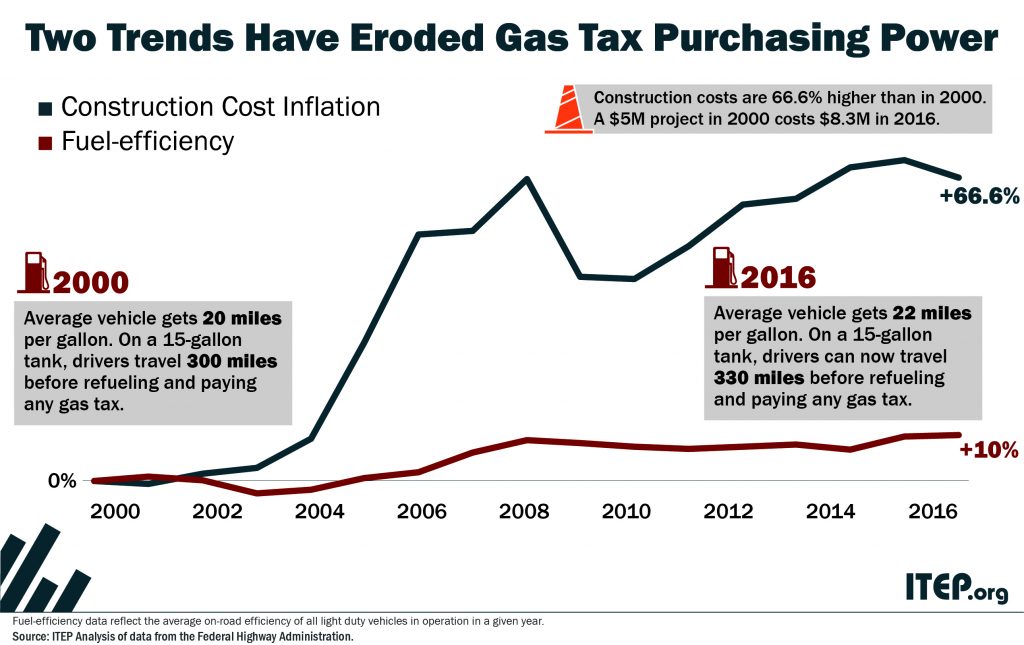
An updated version of this blog was published in April 2019. State tax policy can be a contentious topic, but in recent years there has been a remarkable level of agreement on one tax in particular: the gasoline tax. Increasingly, state lawmakers are deciding that outdated gas taxes need to be raised and reformed to fund infrastructure projects that are vital to their economies.
How the Final GOP-Trump Tax Bill Would Affect Indiana Residents’ Federal Taxes
December 16, 2017 • By ITEP Staff
The final tax bill that Republicans in Congress are poised to approve would provide most of its benefits to high-income households and foreign investors while raising taxes on many low- and middle-income Americans. The bill would go into effect in 2018 but the provisions directly affecting families and individuals would all expire after 2025, with […]
How the House and Senate Tax Bills Would Affect Indiana Residents’ Federal Taxes
December 6, 2017 • By ITEP Staff
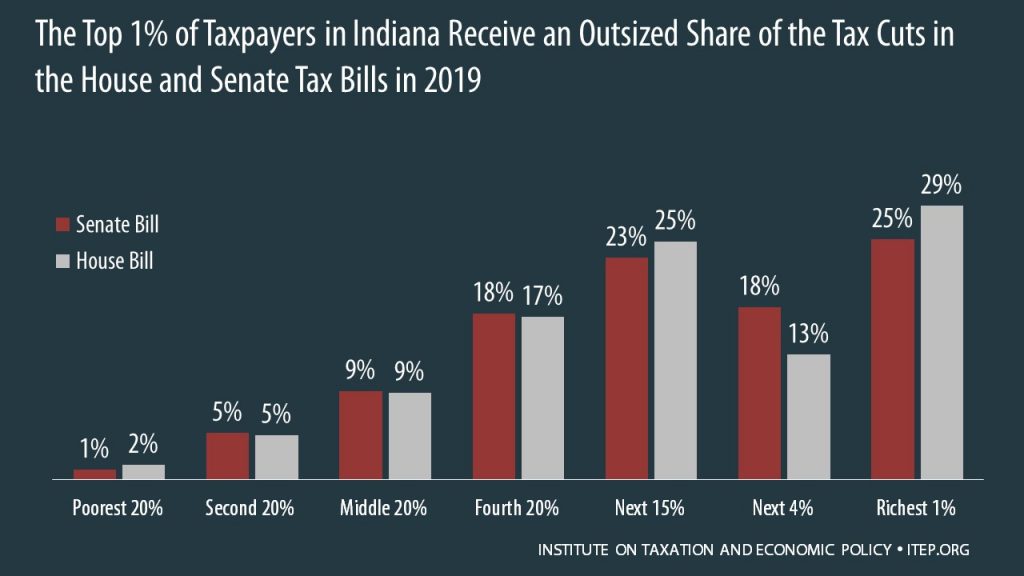
The House passed its “Tax Cuts and Jobs Act” November 16th and the Senate passed its version December 2nd. Both bills would raise taxes on many low- and middle-income families in every state and provide the wealthiest Americans and foreign investors substantial tax cuts, while adding more than $1.4 trillion to the deficit over ten years. The graph below shows that both bills are skewed to the richest 1 percent of Indiana residents.
How the Revised Senate Tax Bill Would Affect Indiana Residents’ Federal Taxes
November 13, 2017 • By ITEP Staff
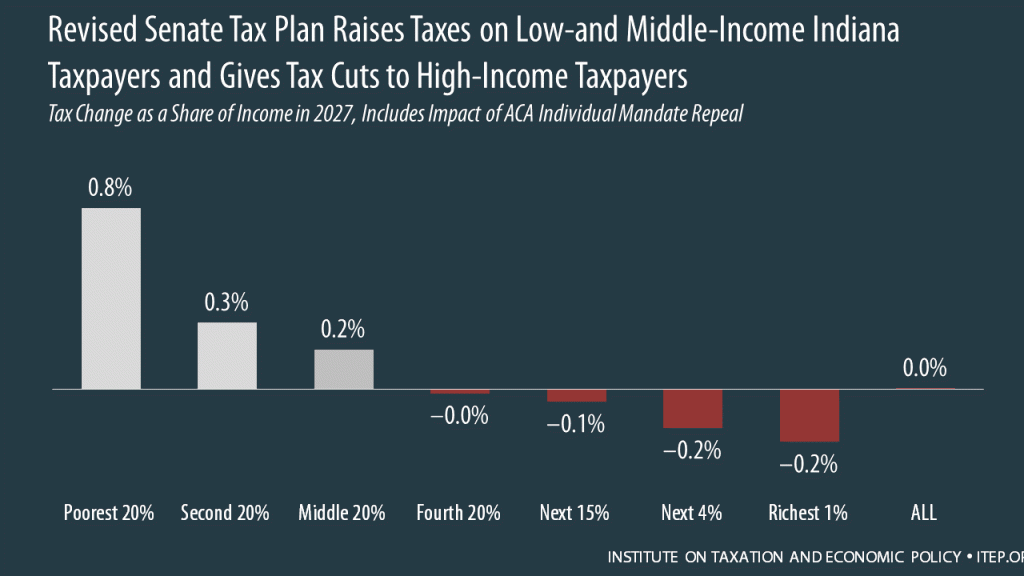
The Senate tax bill released last week would raise taxes on some families while bestowing immense benefits on wealthy Americans and foreign investors. In Indiana, 42 percent of the federal tax cuts would go to the richest 5 percent of residents, and 7 percent of households would face a tax increase, once the bill is fully implemented.
How the House Tax Proposal Would Affect Indiana Residents’ Federal Taxes
November 6, 2017 • By ITEP Staff
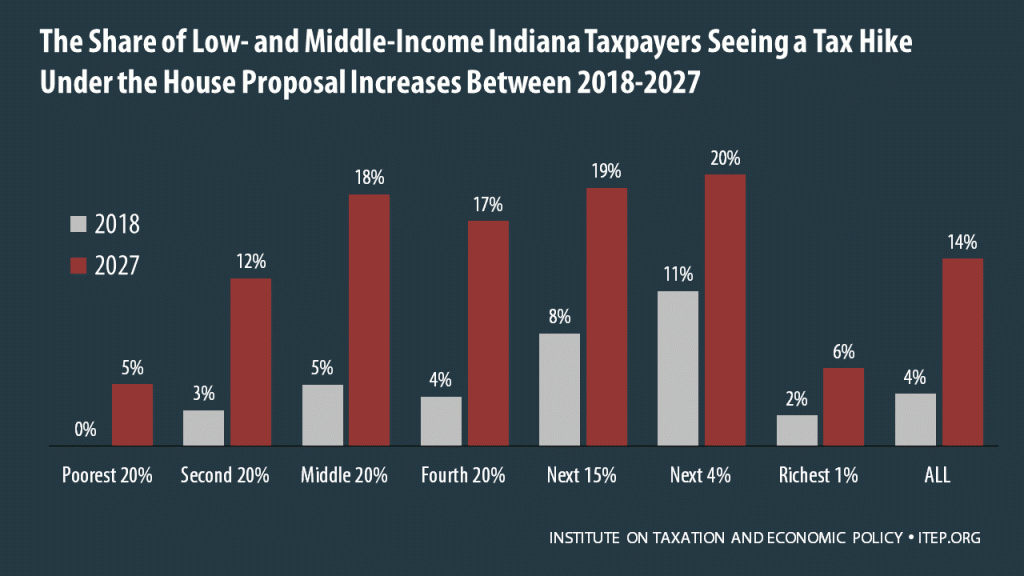
The Tax Cuts and Jobs Act, which was introduced on November 2 in the House of Representatives, includes some provisions that raise taxes and some that cut taxes, so the net effect for any particular family’s federal tax bill depends on their situation. Some of the provisions that benefit the middle class — like lower tax rates, an increased standard deduction, and a $300 tax credit for each adult in a household — are designed to expire or become less generous over time. Some of the provisions that benefit the wealthy, such as the reduction and eventual repeal of the estate…
GOP-Trump Tax Framework Would Provide Richest One Percent in Indiana with 50.4 Percent of the State’s Tax Cuts
October 4, 2017 • By ITEP Staff

The “tax reform framework” released by the Trump administration and congressional Republican leaders on September 27 would not benefit everyone in Indiana equally. The richest one percent of Indiana residents would receive 50.4 percent of the tax cuts within the state under the framework in 2018. These households are projected to have an income of at least $500,500 next year. The framework would provide them an average tax cut of $54,510 in 2018, which would increase their income by an average of 3.5 percent.
Indiana’s Tax Cuts Under Mike Pence Are Not a Model for the Nation
September 29, 2017 • By Carl Davis
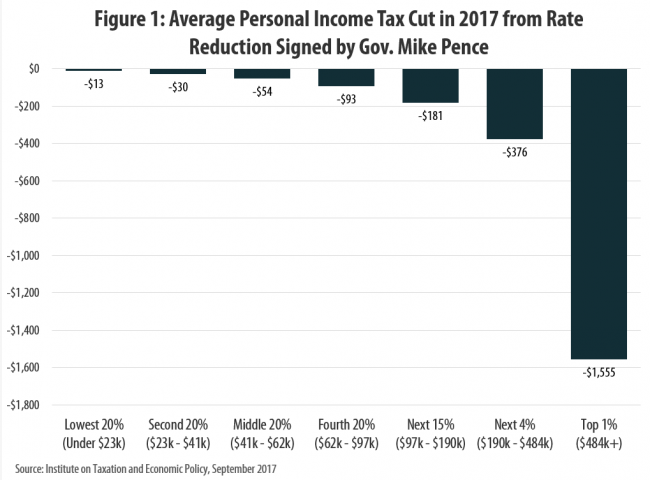
In announcing a new tax cut framework this week in Indianapolis that was negotiated with House and Senate leaders, President Trump claimed that “Indiana is a tremendous example of the prosperity that is unleashed when we cut taxes and set free the dreams of our citizens …. In Indiana, you have seen firsthand that cutting taxes on businesses makes your state more competitive and leads to more jobs and higher paychecks for your workers.”
In Indiana 39.8 Percent of Trump’s Proposed Tax Cuts Go to People Making More than $1 Million
August 17, 2017 • By ITEP Staff
A tiny fraction of the Indiana population (0.4 percent) earns more than $1 million annually. But this elite group would receive 39.8 percent of the tax cuts that go to Indiana residents under the tax proposals from the Trump administration. A much larger group, 43.8 percent of the state, earns less than $45,000, but would receive just 5.6 percent of the tax cuts.
Indiana Institute for Working Families: Trump Tax Plan Would Shortchange Indiana, Middle Class & Working Families (But Would Let Them Eat Cake)
August 15, 2017
A new analysis of the Trump tax plan from the Institute for Taxation and Economic Policy shows that Indiana would only get an 87% share of tax cuts relative to the state’s ratio of the U.S. population. This is the 23rd-smallest share among states. In part because the plan is aimed at high-income households and Indiana is a poorer state, no matter how you slice it, Indiana gets shortchanged compared to the average state by Trump’s plan.
Trump Tax Proposals Would Provide Richest One Percent in Indiana with 46.1 Percent of the State’s Tax Cuts
July 20, 2017 • By ITEP Staff
Earlier this year, the Trump administration released some broadly outlined proposals to overhaul the federal tax code. Households in Indiana would not benefit equally from these proposals. The richest one percent of the state’s taxpayers are projected to make an average income of $1,511,600 in 2018. They would receive 46.1 percent of the tax cuts that go to Indiana’s residents and would enjoy an average cut of $95,940 in 2018 alone.
Investors and Corporations Would Profit from a Federal Private School Voucher Tax Credit
May 17, 2017 • By Carl Davis
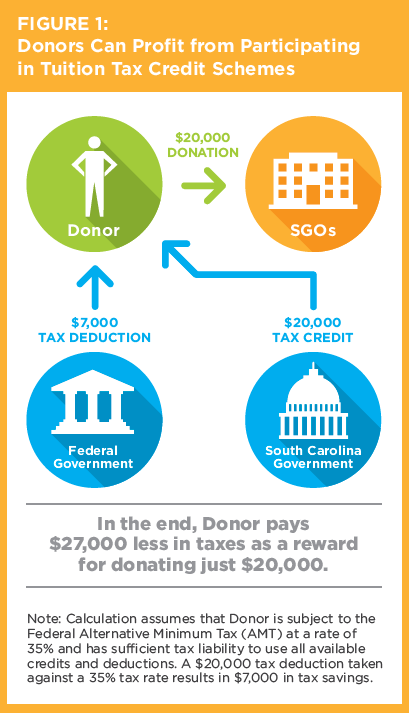
A new report by the Institute on Taxation and Economic Policy (ITEP) and AASA, the School Superintendents Association, details how tax subsidies that funnel money toward private schools are being used as profitable tax shelters by high-income taxpayers. By exploiting interactions between federal and state tax law, high-income taxpayers in nine states are currently able […]
